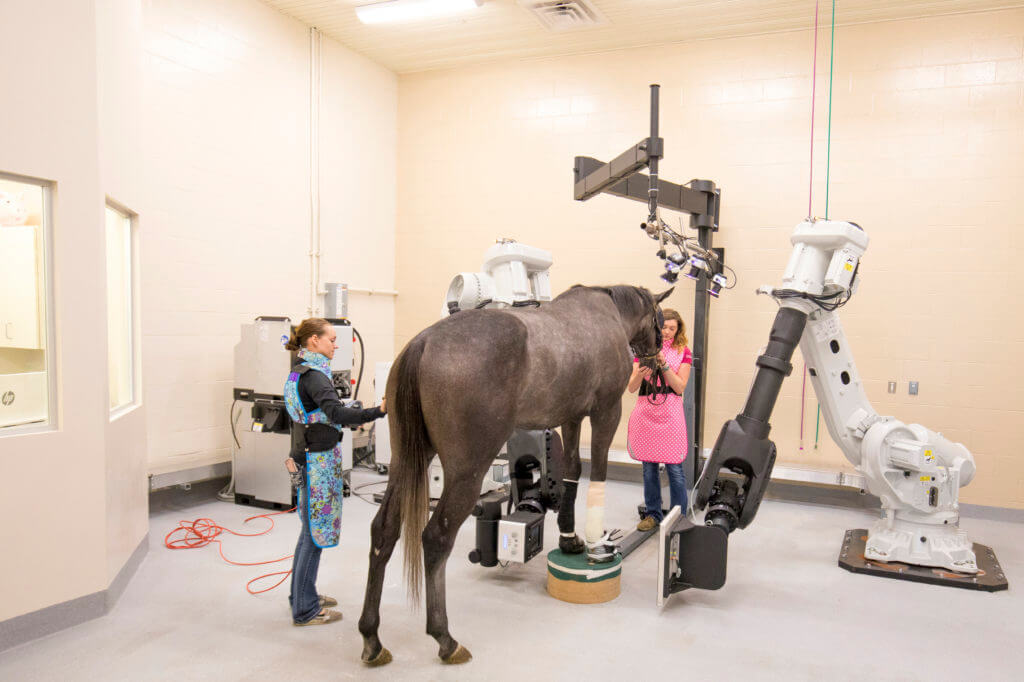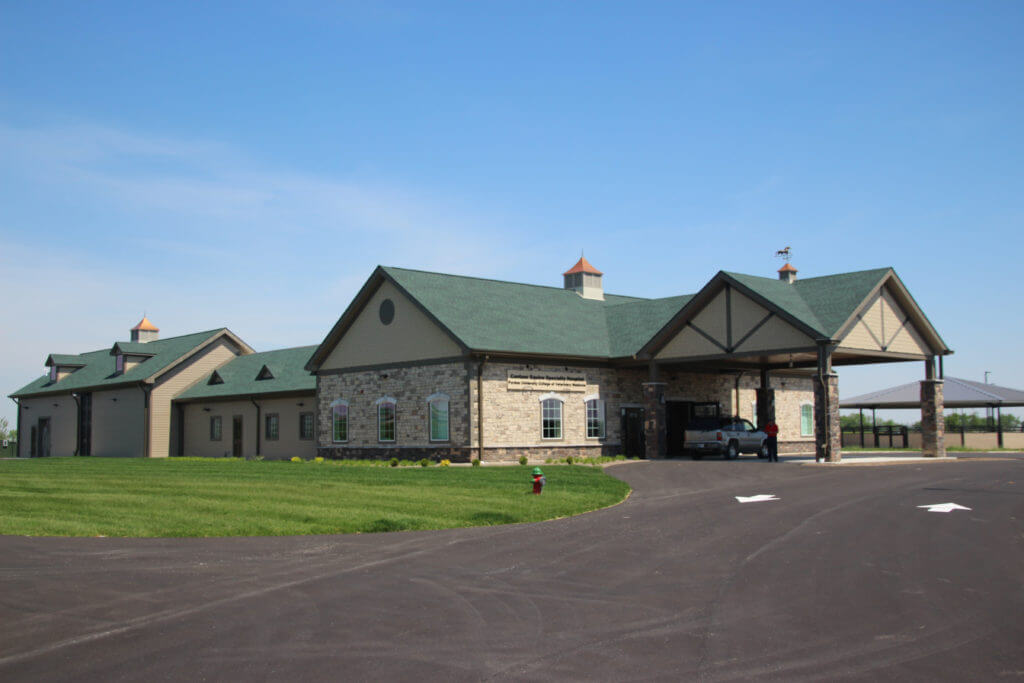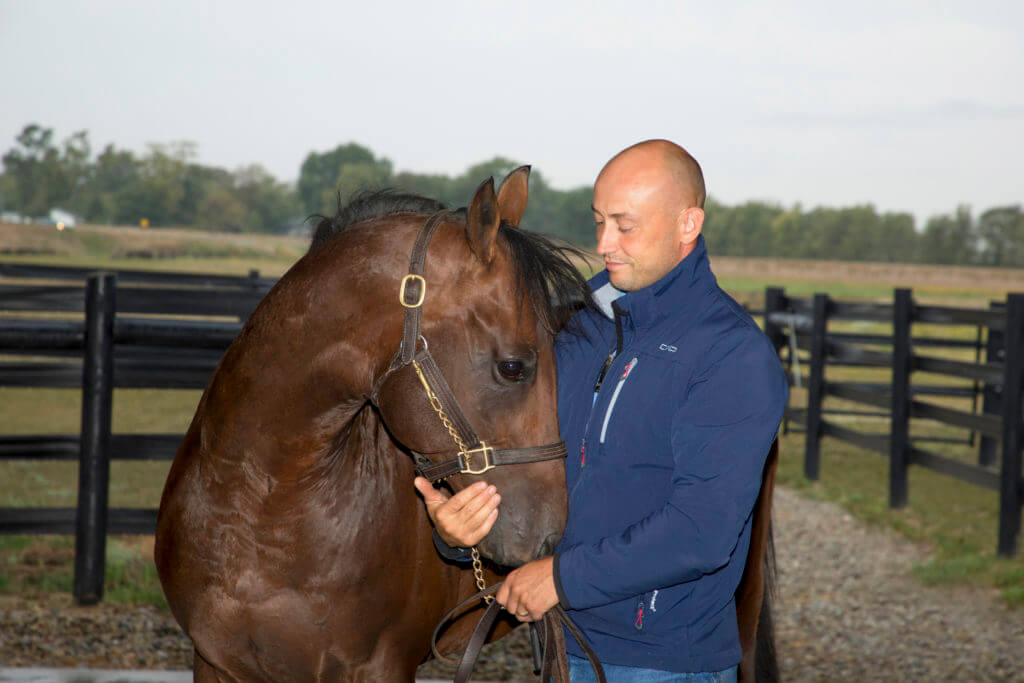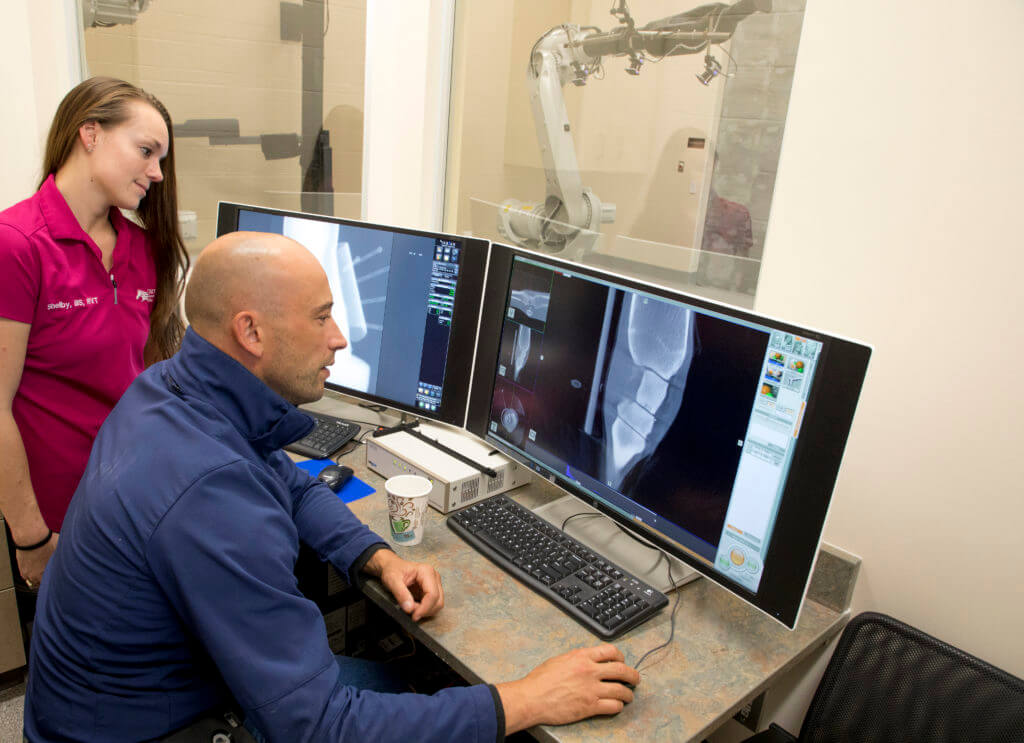Raising the Bar for Equine Care
Make a Gift
Support the College
The Centaur Equine Specialty Hospital in Indiana Offers Midwest Horsemen Access to Advanced Technology
Located in the shadows of the Indiana Grand Racing & Casino outside of Indianapolis is the newly opened Centaur Equine Specialty Hospital, which offers not only the horsemen of the Hoosier State but also horse owners throughout the region access to world-class medical, diagnostic and emergency care services. The equine hospital, which began accepting patients this spring, is a part of the Purdue University College of Veterinary Medicine.
Among the facility’s most notable features is an Equine 4DDI diagnostic imaging system, or standing computerized tomography (CT) machine, which uses two robotic arms to migrate around the equine patient, allowing a horse to walk in and remain standing for diagnostic imaging rather than having to be fully sedated and laid down for fluoroscopy, CT and tomosynthesis.

There are only four standing CT machines for horses in the country, and one of them is located at Centaur Equine Specialty Hospital. Photo courtesy Ed Lausch Photography.
A Vision Turned Reality

Centaur Equine Specialty Hospital is located thirty miles south-east of Indianapolis, and about 100 miles north of Louisville, in Shelbyville, Ind. Photo courtesy Ed Lausch Photography.
Purdue officially broke ground on the $8.8 million project in October 2015, but the idea behind the state-of-the-art equine hospital had been in the works for more than a decade, thanks to a number of interested parties, including longtime Indiana state senator Dr. Bob Jackman, who initially brought the idea up to Purdue College of Veterinary Medicine Dean Dr. Willie Reed.
“Once we passed the slots bill, I was convinced the horse racing industry was going to grow, bringing in more horsemen and horses— Thoroughbreds, Standardbreds, everything,” said Jackman, an equine veterinarian who owns Jackman Animal Clinic in Milroy, Indiana. “I had the opportunity to meet Dr. Reed soon after he took over as dean and mentioned to him that I thought the university should consider building an equine hospital between the two tracks [Indiana Grand and Hoosier Park] because I suspected the quality and number of horses would be increasing due to the new legislation.”
Built on land purchased by the Purdue Research Foundation, the hospital was made possible thanks in part to a $3.1 million pledge that included naming rights from Centaur Gaming, the parent company of Hoosier Park and Indiana Grand. Shelby County, where the hospital is located, also contributed $2.3 million.
The Centaur Equine Specialty Hospital came as a logical complement to the school’s large and small animal teaching hospitals, which provide hands-on and classroom experience for veterinary students.
Purdue has a longstanding history of both benefiting from the success of horse racing in Indiana and pioneering advances in veterinary medicine for the benefit of high-performance equine athletes. The university’s large animal hospital was the first to perform arthroscopic surgery on a horse in the 1970s, and in 1996 they opened their Equine Sports Medicine Center, which featured a high-speed equine treadmill for diagnostic and research purposes. The creation of the Equine Sports Medicine Center came about in large part due to a provision included in the original legislation that established pari-mutuel horse racing in Indiana, which committed funding to Purdue for equine research.
Purdue University also recently announced plans to build a $35 million equine hospital on the campus of the College of Veterinary Medicine. The 76,000-square-foot hospital will include general treatment facilities, modern surgical suites, advanced diagnostic capabilities, and sports medicine and teaching space. The new equine teaching hospital will be the first of a three-phase plan, which will also include new buildings for small animal and food animal teaching hospitals.
Lead Surgeon a Horseman at Heart

Dr. Timm Gudehus and the Centaur Equine Specialty Hospital offer cutting-edge equine technology just a few furlongs from the Indiana Grand Racing & Casino. Photo courtesy Ed Lausch Photography.
At the helm of the Centaur Equine Specialty Hospital is Senior Veterinary Surgeon Timm Gudehus, DVM, DACVS, DECVS, who has a wealth of experience, both as a veterinarian and as a horseman. Growing up in a warmblood riding and breeding family in his native Germany, Gudehus rode show jumpers at the grand prix level before attending veterinary school in Germany and completing an internship on the backside of the Munich racetrack. He came stateside in 2006 to complete a second internship focused on orthopedics in California, and since then has served as a resident in equine surgery at the Louisiana State University School of Veterinary Medicine, as a staff surgeon in Auckland, New Zealand, and as the lead surgeon of one of Europe’s largest and fastest-growing equine hospitals, where his client list included Olympic level competitors.
With experience covering everything from racing breeds and sport horses to breeding stock, Western disciplines and more, Gudehus is well equipped to handle whatever case comes his way at the Centaur Equine Specialty Hospital.
“Having ridden semi-professionally, I understand more than most, probably, that this is a business and that every discipline is different,” he said. “I’ve been afforded the opportunities in my career to work with everything
from polo and show jumping to Thoroughbred and Standardbred racing and breeding and the pony or riding horse that is someone’s beloved pet. Even though it’s a business, as a vet and as a horseman, you have to have that emotional drive as well, and the day I lose that I should stop being a veterinarian.”
When starting a business from the ground up, whether it’s a veterinary hospital or otherwise, key team members are often asked to wear many hats. For Gudehus, that meant serving not only as the hospital’s lead surgeon, but also as its lead communicator in an effort to create relationships with both area horsemen and potential referring veterinarians.
“I’ve spent much of my time reaching out to the veterinarians in the area and letting them know what we have to offer,” he said. “At this point, I’ve made contact with the majority of the veterinarians within a 100 or so mile radius. We are here to support them, not to compete with them. We are an additional resource available for them to use when servicing their clients.”
A Diagnostic Game-Changer

The Equine 4DDI diagnostic imaging system can scan a horse in less than 30 seconds without the horse needing to lie down or be fully sedated. Photo courtesy Ed Lausch Photography.
Since opening this past spring, the Centaur Equine Specialty Hospital has performed more than 100 surgeries including everything from standing tie-backs, removal of ovarian tumors and colic surgeries to neck and other joint fusions.
“Opening a new hospital like ours is very much like a startup business,” Gudehus said. “We had a soft start and are learning what the phases and seasons of our business are going to be.”
The depth of resources housed at the facility is robust, both for emergency cases and for those whose appointments can be scheduled in advance. While its offerings include advanced diagnostic imaging, shockwave therapy, nuclear medicine, regenerative medicine, endoscopic laser surgery and specialized equine orthopedic and soft tissue surgery, the feature that sets them apart more than any other is their standing CT machine.
One of only four in the country and the only one in the Midwest, the standing CT can be a diagnostic game-changer for veterinarians.
“First and foremost, it is a step up from radiography,” Gudehus said. “The scan itself takes about 27 seconds, and with no need for general anesthesia, horses get here and in 15 to 20 minutes they walk in, walk out, done. If you
have a horse that warrants a diagnosis, or if alternative diagnostic tools provided inconclusive results, it’s a no-brainer, and the fact that we have it available right here for horsemen, it’s a game-changer.”
While Purdue’s other veterinary hospitals are teaching hospitals, the Centaur Equine Specialty Hospital operates more along the lines of a traditional specialty practice, but their affiliation to the university makes them
especially eager to offer opportunities for continuing education of horse owners, trainers, caregivers, veterinarians and veterinary students to optimize the health of horses.
In October, the Centaur Equine Specialty Hospital hosted its first continuing education opportunity for veterinarians and horsemen. The seminar focused on best practices for utilizing the hospital’s CT machine, with a lecture given by Tom Yarbrough, DVM, of the Dubai Equine Hospital, which also has one of the machines. A surgeon and diagnostician, Yarbrough is one of the world’s foremost authorities on the standing CT machine.
“The hospitals in the area and even as far as Ohio and Michigan can benefit from what we can offer, and we want to cooperate, not compete, with them,” Gudehus said. “My niche here is not to replace my colleagues, but to enhance what they have available to their clients.”
Writer(s): Jen Roytz, jenlroytz@gmail.com
Source: American Racehorse Magazine, 2017.
